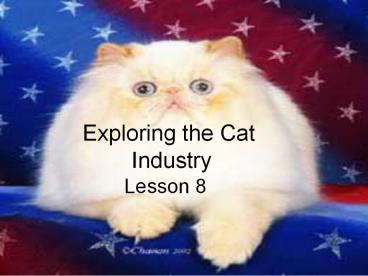Exploring the Cat Industry - PowerPoint PPT Presentation
1 / 26
Title:
Exploring the Cat Industry
Description:
Exploring the Cat Industry ... Companion animal any domestic animal kept for enjoyment and ... come with old habits Breed purebred vs. non-purebred how ... – PowerPoint PPT presentation
Number of Views:220
Avg rating:3.0/5.0
Title: Exploring the Cat Industry
1
Exploring the Cat Industry
- Lesson 8
2
Next Generation Science/Common Core Standards
Addressed!
- RST.11-12.7 Integrate and evaluate multiple
sources of information presented in diverse
formats and media (e.g.,quantitative data, video,
multimedia) in order to address a question or
solve a problem(HS-LS2-6),(HSL2-7),(HS-LS2-8)
problem. - WHST.9-12.9 Draw evidence from informational
texts to support analysis, reflection, and
research. (HS-LS1-1)
3
Work!
- Describe the biology and physiology of a cat.
- Explain classes and breeds of cats.
- Identify management, training, and grooming of
cats. - List considerations when selecting a cat.
4
Terms
- Companion animal
- Declawed
- Hairballs
- Kitten
- Litter
- Neutering
- Queen
- Spaying
- Tomcat
5
Interest Approach
- Display a litter box, cat litter, a pet carrier,
cat brush, and a scratching post along with any
other supplies you have access to. You may offer
extra credit to students to bring these materials
in. Use the supplies to create interest in the
subject by discussing what each item is and what
it is used for.
6
What are terms unique to cats?
- Tomcat
- mature male cat
- Queen
- mature female cat
- Kitten
- baby cat of either sex
- Litter
- a group of kittens born to the same parents
- Companion animal
- any domestic animal kept for enjoyment and
companionship with humans - Declawed
- the cats claws have been surgically removed by a
veterinarian
7
What are terms unique to cats and their anatomy?
- cats are very common
- 60 million are used for companion animals
- Can live up to 30 years
- average is between 12 and 18 years
- weighs from 6 to 15 pounds
- have 250 bones and 500 muscles
- Extra sensitive ears, noses, and paws
- cats are carnivores that can feed on mice and
rats but food has been designed especially for
their needs - have an extra taste organ and can distinguish
between foods - have 3-dimensional vision
- whiskers are attached to nerves to help find
their way in the dark
8
What are terms unique to cats and their anatomy?
- Other animals in the cat family include lions and
tigers. - Similar to these wild animals because their foot
structure are closely designed. - Outside cats need to be quick and agile.
- House cats are declawed to protect carpeting
furniture, and curtains. - Keep declawed cats inside because they no longer
have their most important defense mechanisms.
9
(No Transcript)
10
(No Transcript)
11
Explain classes and breeds of cats.
- Objective 2
12
What are the classes and breeds of cats?
- Many different classes and breeds of cats.
- Purebred or the common house cat
- Two classes of cats
- short-haired
- long-haired
- 36 breeds in the U.S.
- Good website
- http//www.cfainc.org/
- Short-Haired
- popular because less work
- require little to no brushing
- less hair to shed
- Long-Haired
- require more work
- need to be brushed frequently
- often get hairballs
- wads of hair that collect inside the digestive
tract and block the digestion of food
13
(No Transcript)
14
Short-Haired Breeds
American Shorthair
Burmese
Korat
Egyptian Mau
Devon Rex
15
Long-haired Breeds
Balinese
Turkish Angora
Maine Coon
16
Identify management, training and grooming of
cats.
- Objective 3
17
How do I mange my cat?
- Selection
- healthy alert
- medical attention
- vaccinations
- Daily Care
- handle with care to make feel secure
- properly bath groom
- fresh water
- clean bedding
- exercise
- check for mites ticks
- monitor eyes
- clean teeth
- remove plaque tarter
18
How do I train and groom my cat?
- Training
- litter box training
- buy a litter box and some litter
- place in a spot out of your sight
- place cat in box
- show how to scratch paws
- watch cats for signs it has to urinate and place
in box - reward the cat
- Grooming
- brush your cats coat daily
- bath occasionally
- trims nails with a special trimmer
19
Nail Clipping
20
List considerations when selecting a cat.
- Objective 4
21
(No Transcript)
22
What should I consider when selecting a cat?
- tend to be independent and affordable
- Age
- kittens are cute and cuddly
- kittens require more work
- adult cats come with old habits
- Breed
- purebred vs. non-purebred
- how much money do you want to invest
- pedigree cats are more expensive
23
What should I consider when selecting a cat?
- Gender
- unfixed animals
- males may urinate frequently to mark their
territory - females will go through reproductive cycles and
become annoying when in heat - Spaying
- removing the ovaries uterus of a queen
- Neutering
- process of altering a tomcat sexually to prevent
from breeding
24
What should I consider when selecting a cat?
- Medical needs
- consider to fit cat into your budget
- declawing
- spaying or neutering
- vaccinations
25
Review
- What are terms unique to cats and their anatomy?
- What are the classes and breeds of cats?
- How do I manage, train, and groom my cat?
- What should I consider when selecting a cat?
26
The End!































